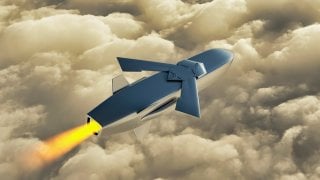Forget Hypersonics: China’s Cruise Missile Threat is the Stuff of Nightmares
While hypersonic weapons often dominate defense discussions, China's rapidly expanding cruise missile arsenal poses an equally significant threat to U.S. forces in the Indo-Pacific. China's advancement in precision-guided cruise missiles, coupled with their robust manufacturing capabilities, has created a formidable anti-access/area-denial strategy.
Summary and Key Points: While hypersonic weapons often dominate defense discussions, China's rapidly expanding cruise missile arsenal poses an equally significant threat to U.S. forces in the Indo-Pacific. China's advancement in precision-guided cruise missiles, coupled with their robust manufacturing capabilities, has created a formidable anti-access/area-denial strategy.
-This growing capability, aimed at deterring the U.S. and projecting power in the region, is shifting the balance of power in favor of Beijing.
-As China's cruise missile systems continue to evolve, the U.S. may find its dominance in the South China Sea and beyond increasingly challenged, bringing the Chinese goal of taking Taiwan closer to reality.
China’s Cruise Missile Arsenal: The Hidden Threat to U.S. Forces
It is easy for Americans to get caught up in the next big thing. This holds especially true when speaking about defense and military technologies. Those of us who analyze military developments professionally often fall prey to this bias. You can see that play out in the fixation, for instance, on the rising threat of hypersonic weapons and the newfangled ways for countering them. Indeed, these are threats.
But sometimes there’s nothing quite like a classic.
Cruise missiles have been a staple of the arsenals of modern militaries for decades. Now, China has begun a rapid program of modernization and expansion of their cruise missile arsenal.
China’s rapidly growing cruise missile arsenal is probably one of the single greatest threats to the safety of U.S. forces operating within range of the things.
The Growth of Chinese Cruise Missile Capabilities
In just a couple of decades, the Chinese cruise missile capability went from rudimentary to highly complex. That threat is still growing, too. Indeed, China has progressed to precision-guided munitions.
Systems like land-attack cruise missiles and anti-ship cruise missiles have proliferated in China’s arsenal. These systems can be launched from ground launchers, aircraft, and navy warships.
The Chinese military capability continues growing into the stuff of nightmares. Courtesy of the manufacturing capabilities the West ceded to China beginning in the 1970s, the Communist dictatorship has progressed technologically to such a point that it has advanced automation capabilities married to their mass-production methods.
What this means is that China can produce these sophisticated, deadly weapons in large numbers – at cost, no less.
China has thus been building a comprehensive and robust capacity for just the kind of high-intensity warfare they would wage against the Americans and their allies for control over the Indo-Pacific.
The Americans are running out of pretty much every weapons system they have, as America’s ailing defense-industrial base is taken to its breaking point in multiple conflicts across the arc of Eurasia. Meanwhile, China’s defense-industrial base is humming along.
China has already built an astounding anti-access/area-denial capability. China plans to use a variety of systems to basically prevent the U.S. military from projecting power into China’s near-abroad during a conflict.
Having a redundant, active, and advanced cruise missile capability ensures Beijing can deny access to key maritime and aerial zones, specifically around the South China Sea and the ultimate prize for China, Taiwan.
So, say goodbye to America’s beloved freedom of navigation.
The Balance of Power No Longer Favors America
China’s significant investment in its cruise missile capability is meant to deter the Americans. What’s more, it offers a significant pre-emptive strike capability, both against U.S. military targets but, more important, against U.S.-backed regional rivals.
These moves are upsetting the balance of power in the Indo-Pacific. Beijing might have already flipped the balance of power in their favor.
Thus, the real concern becomes whether Chinese leaders think this is true, and what they might do if they believe the situation, for now, favors their side over the Americans. The world is already witnessing the staggering hostility that China has exhibited toward the Philippines in the South China Sea.
While many correctly assert that China’s interest in the region is about dominating the energy flows in the region (to some degree, it is), the real point of interest is controlling the southern passes into Taiwan and cutting off U.S.-aligned forces from those passes.
Under normal conditions, China has likely already locked up their near-abroad with these great numbers of cruise missiles. There are things, of course, the Americans and their allies can and should be doing to overcome this Chinese advantage.
Under present conditions, though, the Americans are about to lose their once-dominant position in the Indo-Pacific, specifically in the South China Sea. From there, it is likely the East China Sea will, at the very least, become contested between China and Japan.
Ultimately, however, the main goal for China of taking Taiwan will be much closer to reality than it has ever been.
Author Experience and Expertise: Brandon J. Weichert
Brandon J. Weichert, a National Interest national security analyst, is a former Congressional staffer and geopolitical analyst who is a contributor at The Washington Times, the Asia Times, and The-Pipeline. He is the author of Winning Space: How America Remains a Superpower, Biohacked: China’s Race to Control Life, and The Shadow War: Iran’s Quest for Supremacy. His next book, A Disaster of Our Own Making: How the West Lost Ukraine, is due October 22 from Encounter Books. Weichert can be followed via Twitter @WeTheBrandon.
All images on page Shutterstock. Main image is a generic cruise missile image.
From the Vault
Russia Freaked Out: Why the U.S. Navy 'Unretired' the Iowa-Class Battleships
Battleship vs. Battlecruiser: Iowa-Class vs. Russia's Kirov-Class (Who Wins?)


